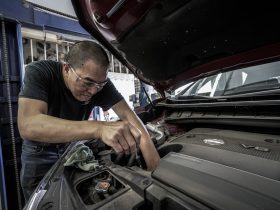Several economic experts admit that fuel prices won’t be going down anytime soon – and it won’t be until 2023 that we begin to see them decrease. Investment research firm Morningstar points at the Personal Consumption Expenditures Price Index (PCE) in the U.S., with inflation expected to peak at about 7% in 2022, before leveling around between 2023 – 2025.
The situation in Australia seems fairly similar, with fuel prices expected to trend around $1.65/liter in 2023. Until we begin to see some relief in Australia, we’ve got some quick ways to save on our petrol, which we’re going to share with you here.
Drive around 90 km/h on the highway.
In 1974, the US Federal Government implemented a 55 miles per hour (90 km/h) National Maximum Speed Law – while this was intended to save lives, it also had the major benefit of reducing fuel consumption by around 1% nationwide.
Research shows that the gas mileage sweet spot for highway driving is around 90 km/h on older vehicles, though newer vehicles may find theirs around 104 km/h. Any higher though, and fuel efficiency will plummet – for example, driving at 128 km/h costs 40% more fuel than 112 km/h.
You’ll also likely save a good bit on your car insurance by respecting speed limits as well – insurance companies like the ones you can compare on iSelect will give better deals to motorists with clean driving records, and stay within the speed limits.
Make a carpool.
It’s easy enough to save hundreds of dollars a year by carpooling. The average Australian family spends over $3,500 yearly on petrol, for one vehicle. Carpooling is a valuable option for commuters, and you can create schedules with people in your neighborhood if you’re going the same way each day.
While ridesharing apps like Uber Pool are popular, don’t neglect social media – just posting on local community Facebook pages can help you find nearby carpools.
Turn off your engine at long traffic lights.
It’s estimated that only 10 seconds of idling costs as much gas as simply starting up your engine – which means traffic lights, with an average of 1 minute interval times between lights, eat up more gas than you realize.
If you arrived at a traffic light just as it was turning red, and you’ve got a minute to wait before it turns green again, go ahead and shut down your engine. Your wallet will thank you for it!
Buy gas on Mondays.
Price charts show that gas prices tend to be their lowest on Monday mornings, thanks to the increased demand for fuel when most people head back to work on Mondays after a long weekend. Fridays are the worst day for gas prices, as many stations peak their prices to capitalize on weekend road-trips.
Make sure your tires are properly inflated.
Under-inflated tires can lower your gas mileage, typically by around 0.2% for every 1 PSI drop below the manufacturer’s minimum. You should keep your tires inflated to their recommended pressure, and have them routinely checked for wear.
Shift into higher gears at the proper times.
If you drive a manual, you should know that driving at higher speeds in lower gears will add unnecessary fuel consumption. You should pay attention to your RPMs, and shift gears as soon as possible.
Note that we’re talking about proper timing to shifting gears – we aren’t advising you to drive at high speeds at all times.







